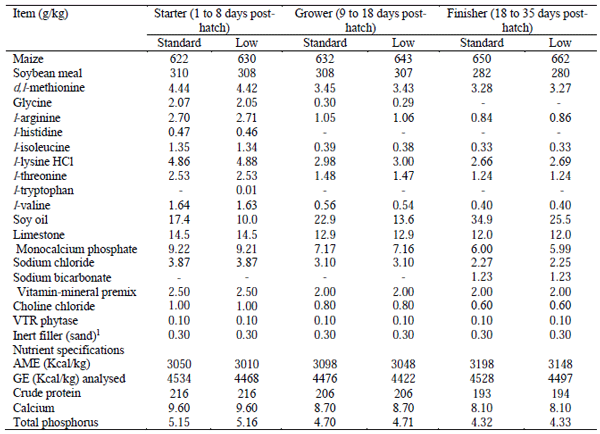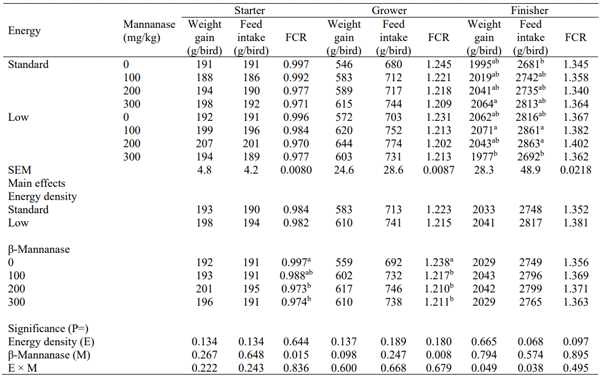I. INTRODUCTION
Mannan is a plant based-NSP derived from polymerisation of mannose sugars, it is categorised as galactomannan or glucomannan based on the presence of galactose and glucose side chains (Aspinall, 1973). Generally, galactomannan is the dominant form in legumes (Sundu et al., 2012). The ratio between mannose to galactose dictates the water solubility of galactomannan where galactose has a strong capacity to bind water and increase gut viscosity. The β-mannan in soybean meal is considered insoluble as it has galactose to mannose ratio of 1:1.8 (Whistler and Smart, 1953; Whistler and Saarnio, 1957); ß-mannan concentrations in soybean meal ranged from 10.2 to 21.2 g/kg (Hsiao et al., 2006). Therefore, ß-mannan is one of the main antinutritive factors in conventional corn-soybean meal broiler diets as it increases gut viscosity, encapsulates dietary nutrients, suppresses energy utilisation, facilitates pathogenic bacterial growth and provokes innate immune responses (Shastak et al., 2015). The feed enzyme, ß-mannanase, degrades ß-mannan and counteracts the negative impacts of ß-mannans in broiler chickens. Therefore, the present study was designed to test the hypothesis that ß-mannanase will improve growth performance and carcass traits in broiler chickens with energy-spearing effects.
II. MATERIAL AND METHODS
This feeding study was conducted in compliance with the guidelines of the Animal Ethics Committee of The University of Sydney. A total of 720 off-sex, male Ross 308 broilers were randomly distributed into 48 floor pens with 15 birds per pen and 6 replicates for each treatment from 1 to 35 days post-hatch. The trial design was a 4 x 2 factorial array of dietary treatments with four inclusions (0, 100, 200, 300 mg/kg) of β-mannanase (VTR Bio-Tech Co., Ltd. Guangdong 519060, China), coupled with standard or low energy densities. Energy densities were reduced by 0.18 MJ in the starter phase and by 0.21 MJ in the grower and finisher phases. The composition and nutrient specifications of the dietary treatments are shown in Table 1. Exogenous phytase (1000 FTU/kg) was included across all dietary treatments. Growth performance from 1 to 35 days post-hatch was monitored and relative abdominal fat-pad weights and carcass traits were determined at 35 days post-hatch. The starter diets were cold-pelleted at approximately 65ºC, whereas the grower and finisher diets were steam-pelleted at a conditioning temperature of 80ºC. Analyses of variance of the experimental data was completed with the JMP Pro 16 program, a 5% level of probability was considered statistically significant and pair-wise comparisons were completed when relevant.
Table 1 - Composition and specifications of standard and low energy density diets in starter, grower and finisher phases.
III. RESULTS
The effects of dietary treatments on broiler feed intake, FCR and growth performance are shown in Table 2. As a main effect, 200 and 300 mg/kg β-mannanase improved FCR (P = 0.015) in starter phase and three levels of β-mannanase improved FCR (P = 0.008) in grower phase relative to β-mannanase free diet. Based on pair-wise comparisons, 200 mg/kg β-mannanase improved FCR in standard energy diets by 2.01% (0.977 versus 0.997; P = 0.010) and by 2.61% (0.970 versus 0.996; P = 0.042) in the starter phase. In the grower phase, the corresponding improvements were 2.17% (1.218 versus 1.245; P = 0.033) and 2.36% (1.202 versus 1.231; P = 0.021). There was a significant treatment interaction on body weight gain and feed intake but not for the FCR in the finisher period.
Table 3 shows the effect of dietary treatments on growth performance for 1 to 35 days post-hatch and carcass traits at 35 days post-hatch. A treatment interaction (P=0.030) was observed for weight gain where 100 or 200 mg/kg β-mannanase added to low energy density diets obtained best body weight gain across all treatments. As a main effect, dietary energy reductions increased feed intake by 3.28% (3784 versus 3664 g/bird; P = 0.027). On average, inclusions of β-mannanase at 100, 200, and 300 mg/kg supported better breast (pectoralis major) yield by 2.85% (192 versus 187 g/kg; P = 0.012), regardless of dietary energy densities. As a main effect, low energy diets supported better pectoralis major yields than standard energy diets (P < 0.001). As a main effect, β-mannanase inclusions reduced relative abdominal fat-pad weights (P < 0.001) where 300 mg/kg β-mannanase reduced fat-pad weights by 24.9% (9.79 versus 13.03 g/kg). Low energy diets reduced relative abdominal fat-pad weights than standard energy diets by 8.05% (10.96 versus 11.92 g/kg; P = 0.002)) as an energy density main effect.
Table 2 - Effect of treatments on growth performance in each feeding phase.
Table 3 - Effect of treatments on growth performance from 1 to 35 days post-hatch and carcass traits at 35 days post-hatch.
IV. DISCUSSION
β-mannanase significantly improved FCR in starter and grower phases, but not in the finisher phase. Interestingly, a similar pattern in responses was reported by Latham et al. (2018) where β-mannanase improved FCR from 1 to 28 days (P < 0.001) but not from 1 to 42 days post-hatch (P > 0.35). This may indicate that anti-nutritive effects of β-mannans are more potent in younger birds. In the present study, energy intakes in low- and standard-energy, control diets (0% β-mannanase) were not significantly different based on pair-wise comparison (standard: 46.79 MJ versus low: 46.04 MJ; P = 0.655) from 1 to 35 days post-hatch, suggesting that broilers in low energy diets achieved their energy requirement by increasing their feed intake. Interestingly, β-mannanase quadratically affected feed intake in low-energy diets (r = 0.596, P = 0.030) where 300 mg/kg β-mannanase inclusion reduced the feed intake, obtaining similar body weight gain and FCR to the control diet with high energy density for overall experimental period. This supports the concept that β-mannnanse has energy-sparing effects in broiler chickens. Nevertheless, there was no significant correlation between β-mannanase inclusion levels and feed intake in standard energy diets.
The significant and positive impact of β-mannanase on relative breast yields is an important outcome for chicken-meat producers. Similarly, Cho and Kim (2013) reported that a β-mannanase increased breast-meat yields in 28-day-old birds offered maize-soy diets. The increased yields were more evident in birds offered lower energy density diets in the present study, where a numerical increase of 6.35% (201 versus 189 g/kg) was observed with 300 mg/kg β-mannanase in low energy diets; whereas, only an increment of 1.09% (186 versus 184 g/kg) was observed in standard energy diets. Moreover, it is deduced from the data that standard energy, control diet generated 1 kg of breast muscle yield by spending 76.7 MJ of dietary ME whereas low-energy diets with 300 mg/kg β-mannanase spent 70.4 MJ dietary ME to generate 1 kg of breast muscle yield.
Curiously, β-mannanase inclusions substantially reduced abdominal fat-pad weights, regardless of dietary energy densities. Higher dietary energy intakes usually generate heavier abdominal fat-pad weights via de novo lipogenesis. Based on the pair-wise comparison, 300 mg/kg β-mannanase increased energy intake by 8.03% (49.74 versus 46.04 MJ; P = 0.035) but reduced abdominal fat-pad weights by 27.3% in standard energy diets. This may indicate a positive impact of β-mannanase on carbohydrate metabolism such that more glucose was directly oxidized, and less glucose converted into fat via de novo lipogenesis.
V. CONCLUSIONS
Inclusion of β-mannanase to maize-soybean based diets showed promise in the present study as it improved FCR from 1 to 18 days, tended to increase weight gain, increased breast meat yield at 35 days post-hatch, while decreasing abdominal fat-pat weight. The increased breast meat yield was more evident in birds offered low energy diets, showing that β-Mannanase could spare 40 to 50 kcal /kg AME.
Presented at the 34th Annual Australian Poultry Science Symposium 2023. For information on the next edition, click here.
















.jpg&w=3840&q=75)